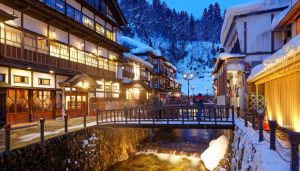Located in the north of the island of Honshu, the Tohoku region of Japan is a remote, scenic area which boasts lush countryside, natural attractions like hot springs and lakes, and spectacular mountain ranges with an abundance of snow perfect for skiing and other winter sports.
With a coastline bordering both the Pacific and the Japan Sea, some prefectures of Tohoku were hit hard by the 2011 earthquake and tsunami. However, most attractions in the area reopened just a few weeks later, and Tohoku continues to be a popular tourist destination in Japan.
Tohuku is also incredibly easy to visit from Tokyo or Hokkaido by Shinkansen bullet train using the JR Pass.
Tohoku prefectures
The Tohoku region consists of the following 6 prefectures:
- Aomori – An incredibly green prefecture which offers a range of natural attractions to explore, such as Lake Towada and the Shirakami Sanchi and Sanriku Fukko national parks.
- Akita – Well known for a wide range of onsen hot springs and the unique Yokote Snow Festival, Akita also hosts Japan’s spectacular annual National Fireworks Competition.
- Iwate – This prefecture is home to Appi Kogen, the premier ski resort in the Tohoku region, as well as the Kitakami park, one of the best places to experience the cherry blossom season in Japan.
- Yamagata – Famous for its ‘snow monsters’ (heavily snow-covered trees) in the winter, Yamagata is also home to Ginzan Onsen, an ancient hot springs town, as well as some of the best ski resorts in the region.
- Miyagi – Home to Sendai, the largest city in the Tohoku Region, Miyagi prefecture also boasts one of the most scenic natural beauty spots in Japan: Matsushima Bay.
- Fukushima – A fertile prefecture full of natural wonders, including the Oze National Park, a popular hiking spot, and the colorful mineral lakes of Goshikinuma.
Top destinations in Tohoku
As it covers much of the north of Japan’s main island, the region of Tokuhu envelops a number of towns and cities that are popular tourist destinations in Japan.
These include the city of Morioka in Iwate prefecture, the traditional post town of Ouchijuku, and Sendai, the largest metropolitan center in Tohoku.
Sendai
Sendai may not be as renowned at the neon metropolis of Tokyo, but it is ranked among Japan’s largest cities. It is also known as “the city of trees.” Why? Sendai features broad streets punctuated by parks and green public spaces. Even its covered shopping arcade has trees growing within it.
Sendai is also home to a rich and vigorous history. The city was founded by a powerful feudal lord around the year 1600. Many of the tourist attractions in Sendai reflect its history and that of its founding family.
Akita
Akita prefecture and its capital, Akita City, is located in the Tohoku Region in the north of Japan’s largest island, Honshu. Akita translates to ‘autumn rice paddy’ in Japanese, and accordingly the prefecture is well-known for its extensive rice farming. It is also famous for its sake breweries and for supposedly being the origin of the Akita dog breed.
Yamagata
The city of Yamagata, capital of the eponymous Yamagata Prefecture, is one of Japan’s premier winter destinations. Surrounded by snowy mountains and natural beauty, Yamagata city is the perfect base to visit the ski slopes, hot springs, national parks, and historic monuments that fill the region.
Located in the north of Honshu (the largest of the islands that make up Japan), Yamagata forms part of the Tōhoku region. It is known for being a hub of winter sports centered around Mount Zao. It is also home to one of the National Treasures of Japan: the Five-storey Gojuto Pagoda of Mount Haguro.
Aomori
Aomori prefecture, located in the Tōhoku region of Japan, boasts a number of spectacular natural landscapes that shouldn’t be missed on a trip to the country. It’s also home to the northernmost prefectural capital city on the main Japanese island of Honshu, Aomori city.
Best things to do in Tohoku
Aside from stunning natural scenery and a range of adventure sports, the Tohoku region offers visitors the chance to discover a number of impressive historical attractions in Japan, including the Chusonji-Konjikido golden temple, a UNESCO World Heritage Site.
Tohoku is also well worth a visit to explore the unique traditional festivals which take place annually in 3 of its major cities: the Kanto Festival in Akita, the Nebuta Festival in Aomori, and the Tanabata Festival in Miyagi.
Main train lines and transportation
The Tohoku region is well served by an extensive network of train and Shinkansen lines, including:
- Tohoku Shinkansen
- Akita Shinkansen
- Yamagata Shinkansen
- Pokemon with You Train
- Joban line
- Uetsu line
- Ou main line
- Tohoku main line
- Senzan line
Other regions of Japan
Japan’s 47 prefectures are traditionally divided into 8 regions. Other than Tohoku, the regions in Japan are as follows:




